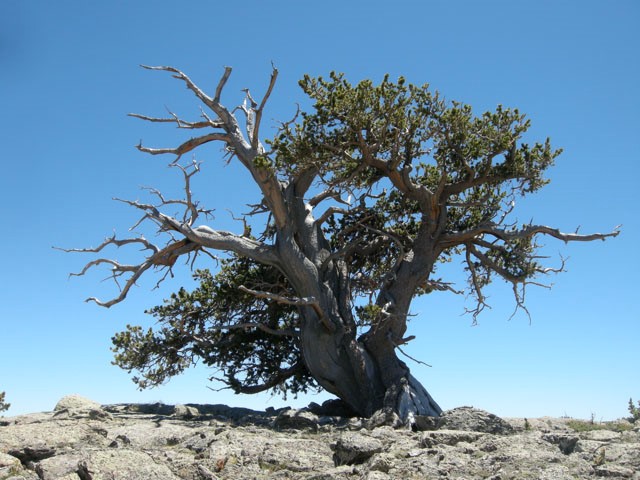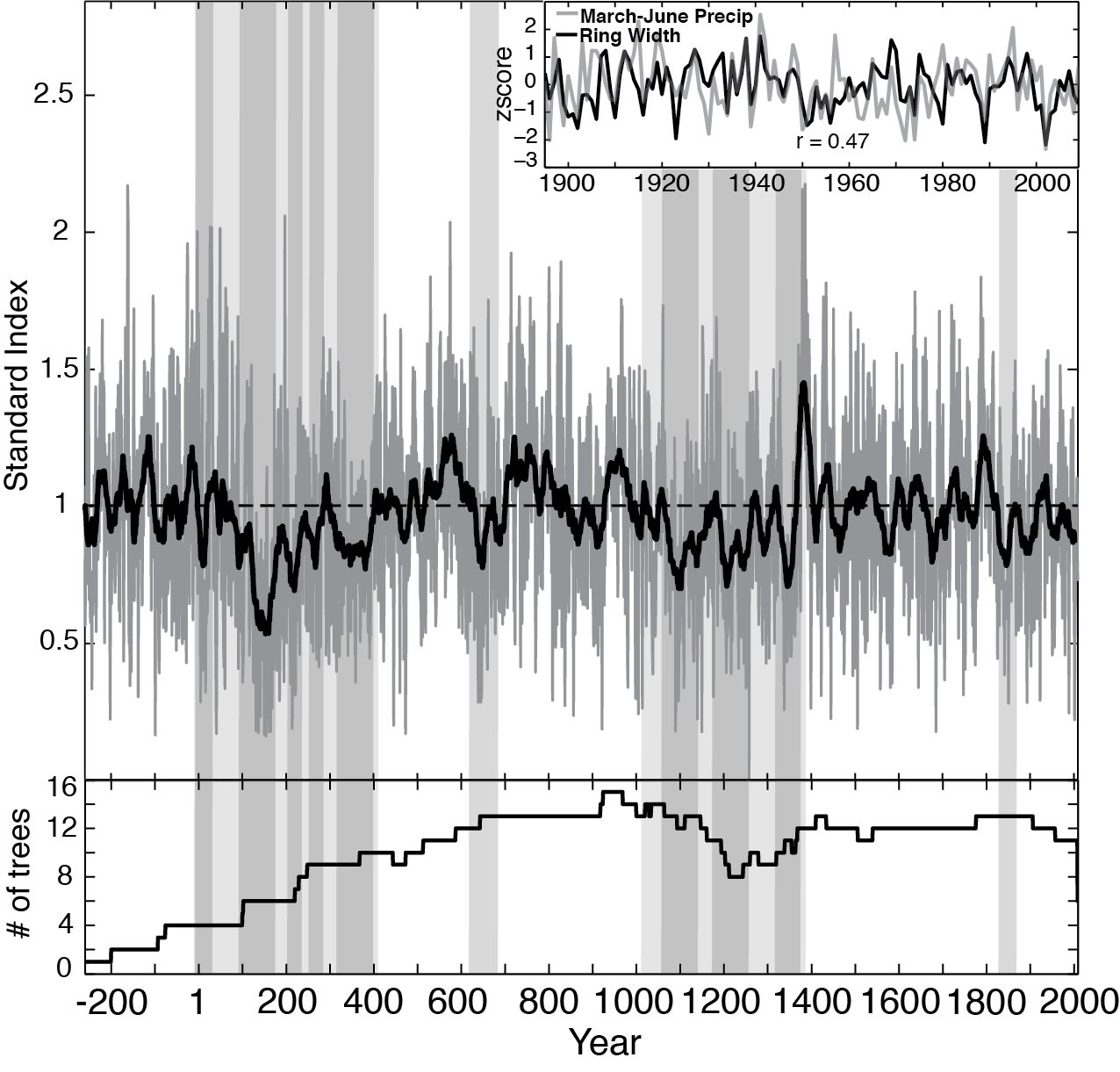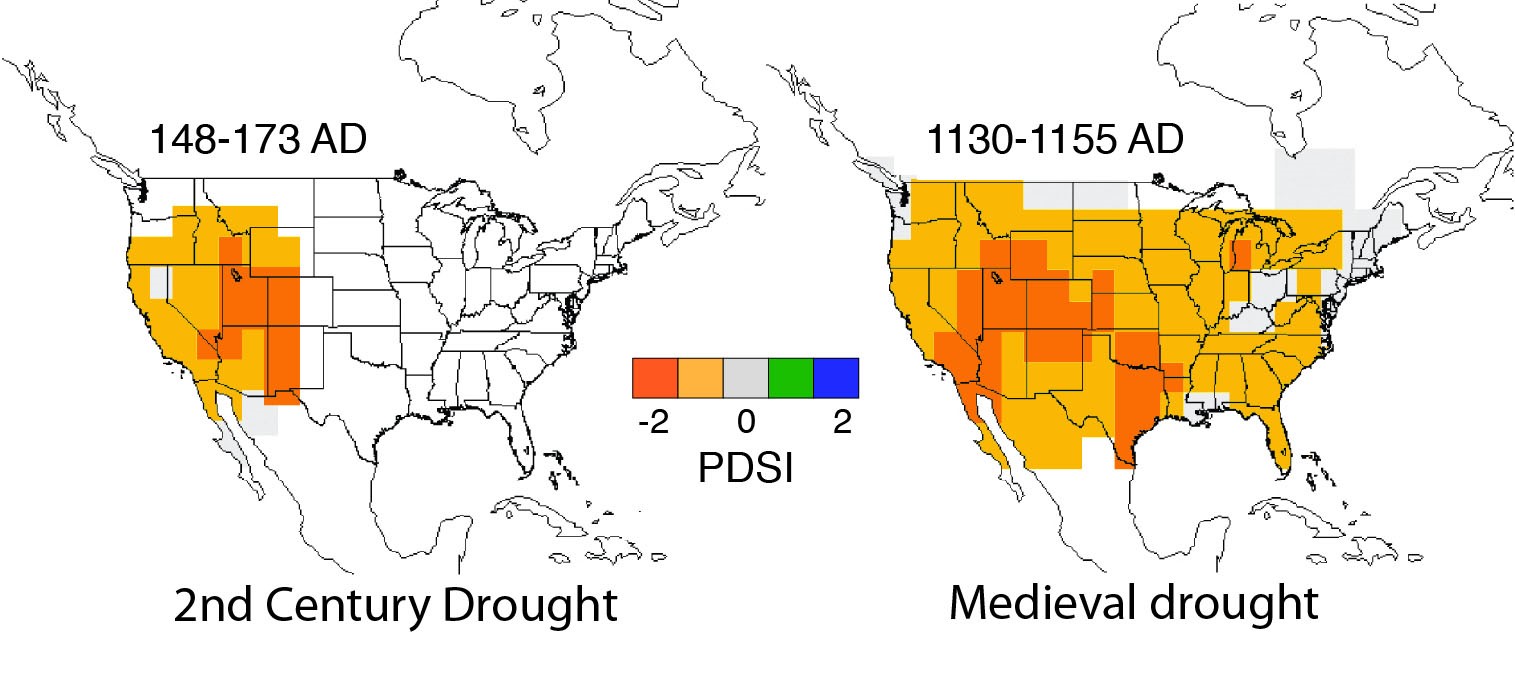Second Century Southwest Megadrought
Scientists have long known that megadroughts, droughts far more extreme than we have experienced during the last 100 years, have occurred from time to time in the Southwest. The 12th and 13th century droughts during medieval times are perhaps the most well-recognized (see blog on 12/4/10). The medieval period in the Southwest, spanning roughly 800-1300 AD, is characterized by increased drought severity, duration, and extent. In a recent study using tree-ring chronologies from Colorado bristlecone pines however, Connie Woodhouse, Jonathan Overpeck, and I revealed an even earlier period of anomalous aridity and drought in the Southwest.

Figure 1. Bristlecone Pine. Photo credit: Cody Routson
To understand medieval drought better, we headed to the south San Juan Mountains – a locale where we know the 12th and 13th century megadroughts occurred. We searched for ancient trees, those that might have lived long enough to record the climate over a thousand years ago. We found several stands of gnarled bristlecone pines, Pinus aristata, growing on south facing slopes of the high elevation peaks (Fig. 1). We took increment cores out of living trees, which are narrow pencil-shaped pieces of wood from which the tree can heal quickly. We also took cross-sections from dead wood lying on the land surface, using chainsaws to cut thin slabs from fallen trunks. We brought the slabs of wood and tree cores back to the lab, where we utilized dendrochronology techniques to date and measure every visible growth ring. A technique called cross-dating was used to match ring-width patterns between trees and assign a calendar date to each growth ring. Using this technique, we could match the patterns of the dead wood ring-widths to those in the early portions of the cores from living trees. We found that some of the living trees were just over 1000 years old. The dead wood, some of which had been sitting on the mountainside in perfect condition for over 1000 years, enabled us to develop a record that is 2268 years long. Comparing the tree-growth pattern with instrumental climate records, we found that these bristlecone pine trees were moisture sensitive, meaning that during wet years they grow wide rings and during dry years they grow narrow rings, and thus archive historic droughts.

Combining samples to create a tree-ring chronology that reflects the common growth pattern among trees at this site, we made an intriguing discovery. In addition to showing increased aridity and drought during the medieval period, the bristlecone pine revealed another period; about 1000 years earlier, of increased aridity, which was punctuated by an extremely severe drought during the 2nd century AD (see Fig. 2). In our record this earlier period of drought appears to be even more severe than medieval drought. Six trees in our record span the 2nd century drought interval, and every one shows dramatic decreases in growth during this period. The chronology shows almost 50 consecutive years of below average growth spanning 122-172 AD, within a much longer period of unusual dryness. Imagine that: 50 years with barely a break from continuous drought!
After finding this event, we were curious to determine if this drought was regionally significant. Few records extend back to the 2nd century AD, but a tree-ring record from El Malpais, New Mexico and another from northern Utah both show the 2nd century drought, suggesting that this was indeed a regional event. Tree-ring reconstructed Palmer Drought Severity Index (PDSI) maps, while again based on very few records during the 2nd century, show that the drought likely extended from Arizona up into Idaho (see Fig. 3). The drought might have reached west into California. We don’t have any idea how far the drought extended east because no tree-ring data are available.

Few records are available to understand the causes of this early period of Southwestern aridity and drought, and the records that do exist have uncertainties. In the available records however, there are intriguing similarities between the early Roman Period, which encompasses the 2nd century drought, and the later Medieval Period. Northern hemisphere temperature, while likely not warmer everywhere, may have been warmer than average during these two periods. Sediment records from the tropical Pacific Ocean indicate there may have been a similar “La Niña-like” base state, accompanied by a change in the number or strength of El Niños during these two periods. The North Atlantic could have been warmer, but again, it is difficult to say with the limited available records.
Our new megadrought record and these initial assessments are a first step toward understanding this early period of drought and aridity in the Southwest. Our record, combined with others, provides strong evidence that this drought was both severe and regional, but more records are needed to show the severity and extent of the 2nd century drought. We found evidence in regional and hemispheric records that the 2nd century and medieval aridity may have been influenced by similar broad-scale climate patterns.
Of course, if a megadrought occurs in the future, it’s almost certainly going to be a good deal hotter than during the ancient megadroughts. A warming climate plus drought is a dangerous mix.
This project would not have happened or been so successful without the research support and field help we received. We received support from the NOAA-funded Climate Assessment for the Southwest, the NSF graduate research fellowship, and the Science Foundation Arizona graduate research fellowship. We also thank Kanin Routson and Dick Yetman for their extensive help in the field. As this project comes to a conclusion, we have set out on a new adventure to understand and characterize these droughts and periods of aridity using lake sediment records, which will provide further clues to the timing and causes of extreme events in the Southwest in the past.
*Routson, C. C., C. A. Woodhouse, and J. T. Overpeck (2011), Second century megadrought in the Rio Grande headwaters, Colorado: How unusual was medieval drought?, Geophys. Res. Lett., 38, L22703, doi:10.1029/2011GL050015.

